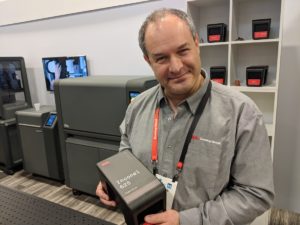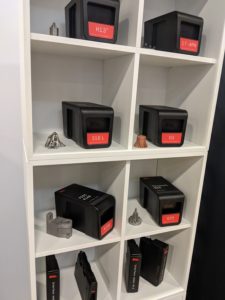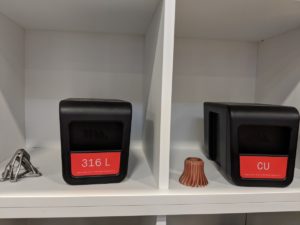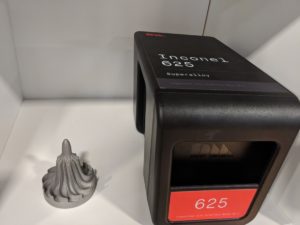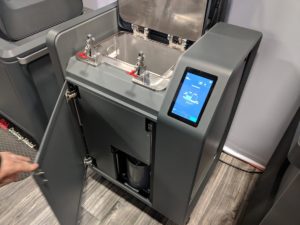Desktop Metal is “Excited to Contribute to the Industry with Our Technology” as Metal 3D Printing Excites the Market
 A year after exploding onto the scene at RAPID + TCT 2017, Boston-based Desktop Metal was back to the event for the 2018 edition, slightly more sedate — if you can call a two-level booth in an exhibit hall sedate. Not a company to do anything small (aside from fine detail in metal 3D printing), Desktop Metal was on the scene in force during the busy show with, as always, plenty to showcase at North America’s largest 3D printing-focused industry event.
A year after exploding onto the scene at RAPID + TCT 2017, Boston-based Desktop Metal was back to the event for the 2018 edition, slightly more sedate — if you can call a two-level booth in an exhibit hall sedate. Not a company to do anything small (aside from fine detail in metal 3D printing), Desktop Metal was on the scene in force during the busy show with, as always, plenty to showcase at North America’s largest 3D printing-focused industry event.
An unmissable presence in the booth was the large Production System, which is shaping up into more of its final form ahead of anticipated shipping starting next year. The updated industrial design is sleek, enhancing the already-appealing lines of the large system. On the smaller end is the Studio System, the desktop from Desktop Metal that began shipping late last year. Around both these systems, including the debinders and sintering furnaces necessary, and the many sample parts, material cartridges, and software displays was, as usual, a crowd of visitors.
It was in this busy hubub that I caught up with Co-Founder and CEO Ric Fulop and Vice President of Marketing Ilya Mirman for a chat. As we spoke, Fulop pointed out parts made for customers including Caterpillar, John Deere, BMW, and Audi.
- Desktop Metal co-founder and CEO Ric Fulop with the DM Production System. Image courtesy of Desktop Metal.
- Ilya Mirman with an Inconel 625 cartridge
“This show has been excellent — for both systems,” Fulop told me of the company’s reception in Fort Worth.
“We’re excited to contribute to the industry with our technology. The booth is alawys slammed! What’s exciting about this system is making parts affordably, cheaper in many cases than forging or casting, just 20 cents per part. Complex assemblies can be made on the Studio System.”
With 3D printing growing in terms of both technology and industry, and metal particularly in the spotlight, it takes a lot these days to truly differentiate. For Desktop Metal, differentiation comes through a variety of forms: its patented technologies, high-profile investors, forward-looking business strategies.
“There are a lot of technologies out there, so we’re looking at where’s the right sweet spot for our systems. There’s a difference between producing in the lab and for manufacturable process. We’re working with customers on how best to turn the knobs,” Mirman noted.
As its systems get out into real-world usage and outside the lab, Desktop Metal is eager to respond to customer feedback. Fulop touched on several of the ways users want to make parts, with a variety of metals and for a variety of applications.
“We’ve validated the concept of prototyping in metal — and it looks like this market is at least as big as for functional plastic prototyping,” Mirman said of market opportunities.
“We look at who’s buying; when we look at our customers, there’s a nice blend of small, medium, and large organizations. The Studio System offers one more capability for a small shop, with two or three machinists, to create parts with complex geometry.”
Bringing metal additive manufacturing in-house opens up opportunities for shops of all sizes to iterate designs and work with new possibilities in part shape. During SOLIDWORKS World earlier this year, Desktop Metal introduced its latest software development, Live Parts, which uses inspiration from processes of growth in the natural world and offers a truly unique approach to generative design. Keen to continue innovating on the geometries possible via 3D printing, the team at Desktop Metal remains enthusiastic about the potential for this process — and, importantly, what it can offer to users. Live Parts, as Senior Software Engineer Andy Roberts noted during a private demo at SWW, goes beyond biomimicry and, inspired by cellular growth, “grows parts as if they were living organisms.”
Also in response to customer query, the company has been focusing on hard metals, Fulop noted, as Inconel and copper are in demand, albeit not the easiest to formulate for 3D printing. Mirman held up a cartidge of Inconel for use in the Studio System. The idea of putting Inconel in a cartridge at all, he noted, is unique, as it minimizes potential difficulties in material handling.
“The process is clean, and approved in California,” Fulop added, touching on the debinding and sintering processes, particularly as related to the US state with some of the strictest environmental regulations in place. Operation is ensured to be safe in office and factory environments, he said, noting, “All this fits through the door and needs no venting.”
Fulop provided a look inside the debinder:
Already, customers running the Studio System are seeing the advantages of in-house 3D printing. Last month, Lumenium reported drops in cost (from $980 to $148 for a saddle carrier), mass (from 1,158 grams to 933 grams), and product development timeline (by 25%) by incorporating the solution into its operations.
Catching up with Desktop Metal always provides an interesting look at different aspects of the company’s offerings and operations. As the company only continues to pick up steam in 3D printing, the industry also benefits from the team’s willingness to share insights and expertise.
Discuss Desktop Metal, metals, and other 3D printing topics at 3DPrintBoard.com or share your thoughts in the Facebook comments below.
[All photos/video: Sarah Goehrke]
Subscribe to Our Email Newsletter
Stay up-to-date on all the latest news from the 3D printing industry and receive information and offers from third party vendors.
You May Also Like
IperionX Inks 10-Year Deal with Wisconsin Manufacturer for 80 Metric Tons of Titanium Per Year
IperionX, the Charlotte-based supplier of sustainable titanium powders used for additive manufacturing (AM) and metal injection molding (MIM), has signed a ten-year deal with United Stars, a group of industrial...
Gastronology Launches Industrial Production of 3D Printed Food for Dysphagia Patients
Food 3D printing has, in many ways, been an additive manufacturing (AM) segment looking for the right business case. While some applications are beautiful and others may or may not...
Lockheed Martin Leads $3M Investment in Q5D’s Electronics 3D Printing System
Q5D, an original equipment manufacturer (OEM) of robotic arm, hybrid additive manufacturing (AM) systems used for wire harness production, has closed a $3 million investment round. The investment arm of...
3D Printing News Briefs, April 6, 2024: Depowdering, Cybertruck Door Handles, & More
In today’s 3D Printing News Briefs, ioTech’s digital manufacturing CLAD technology is opening up opportunities for microelectronics and additive manufacturing. Hexagon and Raytheon Technologies commercially released the Simufact Additive Process...



